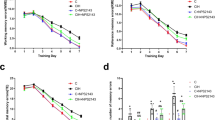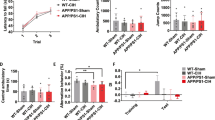Abstract
Purpose
Chronic intermittent hypoxia (CIH) is a major cause of cognitive dysfunction in people with obstructive sleep apnea syndrome (OSAS), as it damages synapse structure, and function. This study aimed to investigate the potential mechanisms resulting in cognitive impairment caused by CIH in patients with OSAS.
Methods
Healthy adult SD male rats (n = 36) were randomly divided into four groups: control, CIH, WP1066, and dimethyl sulfoxide (DMSO). The CIH, WP1066, and DMSO groups were exposed to intermittent hypoxic environments for 8 h per day for 28 d. The WP1066 group received intraperitoneal injection of WP1066, a selective signal transducer and activator of transcription-3 (STAT3) inhibitor. All the experimental rats were subjected to the Morris water maze. Hippocampal tissue samples (n = 6 per group) were used for western blot analysis, and brain tissue samples (n = 3 per group) were used for immunohistochemistry and hematoxylin and eosin staining.
Results
The cognition of rats exposed to prolonged CIH was impaired. P-STAT3 expression was found to be higher in CIH rats than in control rats. Postsynaptic density95 (PSD95) expression was significantly reduced in rats with CIH-induced learning and memory impairment, but it significantly increased after the STAT3 signaling pathway was blocked, which improved learning and memory ability. However, inhibition of the STAT3 signaling pathway failed to improve the decline of synaptophysin (SYP) protein caused by CIH.
Conclusions
When rats are exposed to CIH, STAT3 in the brain is activated, PSD95 and SYP levels decrease, and cognition is impaired. Inhibition of the STAT3 signaling pathway increases PSD95 to recover postsynaptic plasticity, thereby improving cognitive dysfunction.









Similar content being viewed by others
Data availability
The datasets generated during and/or analyzed during the current study are available from the corresponding author on reasonable request.
References
Benfenati F (2007) Synaptic plasticity and the neurobiology of learning and memory. Acta Biomed 78(Suppl 1):58–66
Sharma SK (2010) Protein acetylation in synaptic plasticity and memory. Neurosci Biobehav Rev 34(8):1234–1240. https://doi.org/10.1016/j.neubiorev.2010.02.009
Brachya G, Yanay C, Linial M (2006) Synaptic proteins as multi-sensor devices of neurotransmission. BMC Neurosci 7 Suppl 1(Suppl 1):S4.https://doi.org/10.1186/1471-2202-7-S1-S4
Kolos YA, Grigoriyev IP, Korzhevskyi DE (2015) A synaptic marker synaptophysin. Morfologiia 147(1):78–82
Harper CB, Blumrich EM, Cousin MA (2021) Synaptophysin controls synaptobrevin-II retrieval via a cryptic C-terminal interaction site. J Biol Chem 296:100266. https://doi.org/10.1016/j.jbc.2021.100266
Schiebler W, Jahn R, Doucet JP, Rothlein J, Greengard P (1986) Characterization of synapsin I binding to small synaptic vesicles. J Biol Chem 261(18):8383–8390
Valtorta F, Pennuto M, Bonanomi D, Benfenati F (2004) Synaptophysin: leading actor or walk-on role in synaptic vesicle exocytosis. BioEssays 26(4):445–453. https://doi.org/10.1002/bies.20012
Gordon SL, Leube RE, Cousin MA (2011) Synaptophysin is required for synaptobrevin retrieval during synaptic vesicle endocytosis. J Neurosci 31(39):14032–14036. https://doi.org/10.1523/JNEUROSCI.3162-11.2011
Kaempf N, Kochlamazashvili G, Puchkov D, Maritzen T, Bajjalieh SM, Kononenko NL, Haucke V (2015) Overlapping functions of stonin 2 and SV2 in sorting of the calcium sensor synaptotagmin 1 to synaptic vesicles. Proc Natl Acad Sci U S A 112(23):7297–7302. https://doi.org/10.1073/pnas.1501627112
Kokotos AC, Harper CB, Marland J, Smillie KJ, Cousin MA, Gordon SL (2019) Synaptophysin sustains presynaptic performance by preserving vesicular synaptobrevin-II levels. J Neurochem 151(1):28–37. https://doi.org/10.1111/jnc.14797
Gordon SL, Cousin MA (2014) The Sybtraps: control of synaptobrevin traffic by synaptophysin, α-synuclein and AP-180. Traffic 15(3):245–254. https://doi.org/10.1111/tra.12140
Park Y, Ryu JK (2018) Models of synaptotagmin-1 to trigger Ca(2+)-dependent vesicle fusion. FEBS Lett 592(21):3480–3492. https://doi.org/10.1002/1873-3468.13193
Chang CW, Hsiao YT, Jackson MB (2021) Synaptophysin regulates fusion pores and exocytosis mode in chromaffin cells. J Neurosci 41(16):3563–3578. https://doi.org/10.1523/JNEUROSCI.2833-20.2021
Collingridge GL, Volianskis A, Bannister N, France G, Hanna L, Mercier M, Tidball P, Fang G, Irvine MW, Costa BM, Monaghan DT, Bortolotto ZA, Molnár E, Lodge D, Jane DE (2013) The NMDA receptor as a target for cognitive enhancement. Neuropharmacology 64:13–26. https://doi.org/10.1016/j.neuropharm.2012.06.051
Hsieh CP, Chen ST, Lee MY, Huang CM, Chen HH, Chan MH (2021) N, N-dimethylglycine protects behavioral disturbances and synaptic deficits induced by repeated ketamine exposure in mice. Neuroscience 472:128–137. https://doi.org/10.1016/j.neuroscience.2021.08.004
Sutton MA, Schuman EM (2006) Dendritic protein synthesis, synaptic plasticity, and memory. Cell 127(1):49–58. https://doi.org/10.1016/j.cell.2006.09.014
Kim E, Sheng M (2004) PDZ domain proteins of synapses. Nat Rev Neurosci 5(10):771–781. https://doi.org/10.1038/nrn1517
Cho KO, Hunt CA, Kennedy MB (1992) The rat brain postsynaptic density fraction contains a homolog of the Drosophila discs-large tumor suppressor protein. Neuron 9(5):929–942. https://doi.org/10.1016/0896-6273(92)90245-9
Zhang H, Etherington LA, Hafner AS, Belelli D, Coussen F, Delagrange P, Chaouloff F, Spedding M, Lambert JJ, Choquet D, Groc L (2013) Regulation of AMPA receptor surface trafficking and synaptic plasticity by a cognitive enhancer and antidepressant molecule. Mol Psychiatry 18(4):471–484. https://doi.org/10.1038/mp.2012.80
Abbasi B, Goldenholz DM (2019) Machine learning applications in epilepsy. Epilepsia 60(10):2037–2047. https://doi.org/10.1111/epi.16333
Lin CS, Tao PL, Jong YJ, Chen WF, Yang CH, Huang LT, Chao CF, Yang SN (2009) Prenatal morphine alters the synaptic complex of postsynaptic density 95 with N-methyl-D-aspartate receptor subunit in hippocampal CA1 subregion of rat offspring leading to long-term cognitive deficits. Neuroscience 158(4):1326–1337. https://doi.org/10.1016/j.neuroscience.2008.11.007
Kakizawa S, Shibazaki M, Mori N (2012) Protein oxidation inhibits NO-mediated signaling pathway for synaptic plasticity. Neurobiol Aging 33(3):535–545. https://doi.org/10.1016/j.neurobiolaging.2010.04.016
Hofmann HD, Kirsch M (2012) JAK2-STAT3 signaling: a novel function and a novel mechanism. JAKSTAT 1(3):191–193. https://doi.org/10.4161/jkst.20446
Morrell MJ, McRobbie DW, Quest RA, Cummin AR, Ghiassi R, Corfield DR (2003) Changes in brain morphology associated with obstructive sleep apnea. Sleep Med 4(5):451–454. https://doi.org/10.1016/s1389-9457(03)00159-x
Cha J, Zea-Hernandez JA, Sin S, Graw-Panzer K, Shifteh K, Isasi CR, Wagshul ME, Moran EE, Posner J, Zimmerman ME, Arens R (2017) The effects of obstructive sleep apnea syndrome on the dentate gyrus and learning and memory in children. J Neurosci 37(16):4280–4288. https://doi.org/10.1523/JNEUROSCI.3583-16.2017
Khuu MA, Pagan CM, Nallamothu T, Hevner RF, Hodge RD, Ramirez JM, Garcia AJ 3rd (2019) Intermittent hypoxia disrupts adult neurogenesis and synaptic plasticity in the dentate gyrus. J Neurosci 39(7):1320–1331. https://doi.org/10.1523/JNEUROSCI.1359-18.2018
Wall AM, Corcoran AE, O’Halloran KD, O’Connor JJ (2014) Effects of prolyl-hydroxylase inhibition and chronic intermittent hypoxia on synaptic transmission and plasticity in the rat CA1 and dentate gyrus. Neurobiol Dis 62:8-17 https://doi.org/10.1016/j.nbd.2013.08.016
Tian M, Stroebel D, Piot L, David M, Ye S, Paoletti P (2021) GluN2A and GluN2B NMDA receptors use distinct allosteric routes. Nat Commun 12(1):4709. https://doi.org/10.1038/s41467-021-25058-9
Monaco SA, Gulchina Y, Gao WJ (2015) NR2B subunit in the prefrontal cortex: a double-edged sword for working memory function and psychiatric disorders. Neurosci Biobehav Rev 56:127–138. https://doi.org/10.1016/j.neubiorev.2015.06.022
Wang MJ, Li YC, Snyder MA, Wang H, Li F, Gao WJ (2013) Group II metabotropic glutamate receptor agonist LY379268 regulates AMPA receptor trafficking in prefrontal cortical neurons. PLoS ONE 8(4):e61787. https://doi.org/10.1371/journal.pone.0061787
Bustos FJ, Varela-Nallar L, Campos M, Henriquez B, Phillips M, Opazo C, Aguayo LG, Montecino M, Constantine-Paton M, Inestrosa NC, van Zundert B (2014) PSD95 suppresses dendritic arbor development in mature hippocampal neurons by occluding the clustering of NR2B-NMDA receptors. PLoS ONE 9(4):e94037. https://doi.org/10.1371/journal.pone.0094037
Hardingham GE (2006) 2B synaptic or extrasynaptic determines signalling from the NMDA receptor. J Physiol 572(Pt 3):614–615. https://doi.org/10.1113/jphysiol.2006.109603
Li X, Wang C, Wang W, Yue C, Tang Y (2017) Neonatal exposure to BDE 209 impaired learning and memory, decreased expression of hippocampal core SNAREs and synaptophysin in adult rats. Neurotoxicology 59:40–48. https://doi.org/10.1016/j.neuro.2017.01.004
Zhang L, Zhao Q, Chen CH, Qin QZ, Zhou Z, Yu ZP (2014) Synaptophysin and the dopaminergic system in hippocampus are involved in the protective effect of rutin against trimethyltin-induced learning and memory impairment. Nutr Neurosci 17(5):222–229. https://doi.org/10.1179/1476830513Y.0000000085
Qi QR, Yang ZM (2014) Regulation and function of signal transducer and activator of transcription 3. World J Biol Chem 5(2):231–239. https://doi.org/10.4331/wjbc.v5.i2.231
Hindam MO, Sayed RH, Skalicka-Woźniak K, Budzyńska B, El Sayed NS (2020) Xanthotoxin and umbelliferone attenuate cognitive dysfunction in a streptozotocin-induced rat model of sporadic Alzheimer’s disease: the role of JAK2/STAT3 and Nrf2/HO-1 signalling pathway modulation. Phytother Res 34(9):2351–2365. https://doi.org/10.1002/ptr.6686
Hristova M, Rocha-Ferreira E, Fontana X, Thei L, Buckle R, Christou M, Hompoonsup S, Gostelow N, Raivich G, Peebles D (2016) Inhibition of signal transducer and activator of transcription 3 (STAT3) reduces neonatal hypoxic-ischaemic brain damage. J Neurochem 136(5):981–994. https://doi.org/10.1111/jnc.13490
Reichenbach N, Delekate A, Plescher M, Schmitt F, Krauss S, Blank N, Halle A, Petzold GC (2019) Inhibition of Stat3-mediated astrogliosis ameliorates pathology in an Alzheimer's disease model. EMBO Mol Med 11(2). https://doi.org/10.15252/emmm.201809665
Acknowledgements
This research was supported by the National Natural Science Foundation of China (81660194). The present study was also supported by the Key Laboratory of Basic Pharmacology of Ministry of Education, Zunyi Medical University, Zunyi, Guizhou, China, 563003. We thank all the partners and staff who helped us in the process of this study.
Funding
The National Natural Science Foundation of China provided financial support in the form of grant funding (Grant No: 81660194). The sponsor had no role in the design or conduct of this research.
Author information
Authors and Affiliations
Corresponding author
Ethics declarations
Ethical approval
All the applicable international, national, and/or institutional guidelines for the care and use of animals were followed. All the procedures performed in the studies involving animals were in accordance with the ethical standards of the institution or practice at which the studies were conducted.
Competing interests
All the authors certify that they have no affiliations with, or involvement in, any organization or entity with any financial interest or non-financial interest in the subject matter or materials discussed in this manuscript.
Additional information
Publisher's note
Springer Nature remains neutral with regard to jurisdictional claims in published maps and institutional affiliations.
Rights and permissions
About this article
Cite this article
Wang, J., Xu, Z., Xu, L. et al. Inhibition of STAT3 signal pathway recovers postsynaptic plasticity to improve cognitive impairment caused by chronic intermittent hypoxia. Sleep Breath 27, 893–902 (2023). https://doi.org/10.1007/s11325-022-02671-6
Received:
Revised:
Accepted:
Published:
Issue Date:
DOI: https://doi.org/10.1007/s11325-022-02671-6




